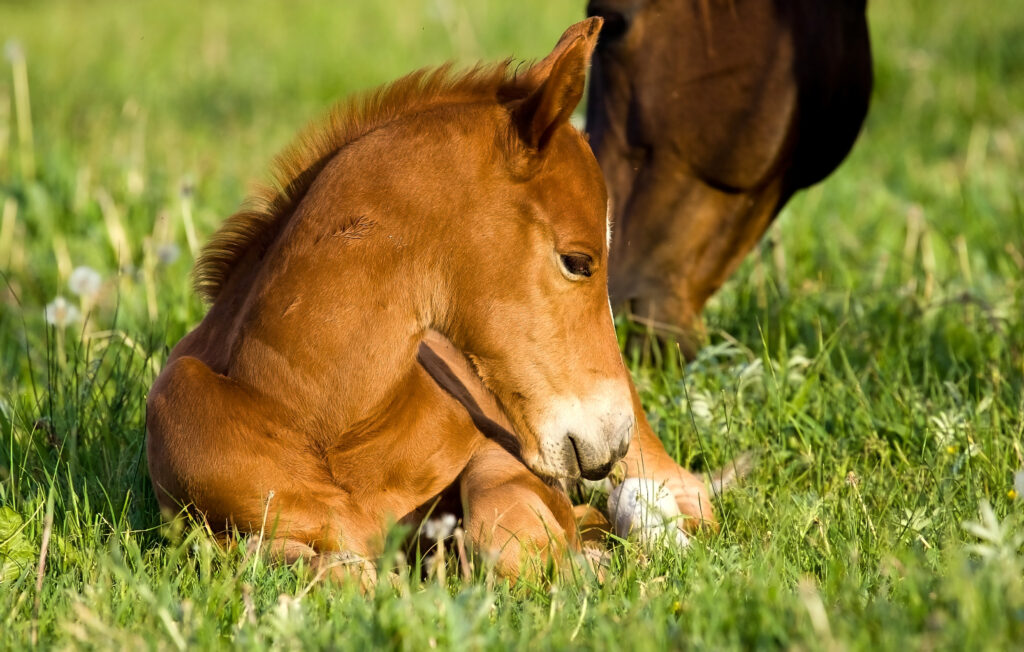
Since the discovery of equine rotavirus B (ERVB) by the University of Kentucky Martin-Gatton College of Food, Agriculture, and Environment’s Department of Veterinary Science in 2021, ongoing research has focused on developing tools to protect foals against infection. The equine industry has answered the call for financial help and raised significant funds to go toward vaccine development and antibody synthesis strategies. Internal funds from the university will also go toward this cause.
About Equine Rotavirus
Rotavirus is highly contagious with extrapolated data suggesting only hundreds to thousands of infectious virus particles are needed to infect susceptible foals. This makes biosecurity a challenge. Measures farms have employed to break the cycle in an outbreak or prevent infection include foaling outside with personnel wearing personal protective equipment, minimal handling of the foal for the first week of life other than the customary foal exam at 12-24 hours of age, and rigorous observance of staff/traffic/horse movement in the foaling barn. Control of infection during an outbreak is a considerable challenge, emphasizing the need for a protective vaccine.
Rotavirus Vaccine Development Challenges
One significant hurdle in the development of ERVB-directed treatment and prevention tools is the inability to grow the virus in a laboratory. The currently available equine rotavirus A (ERVA) G3[P12] vaccine was developed from a cell-adapted strain of ERVA. This vaccine has made neonatal ERVA extremely rare when foals are born to appropriately vaccinated mares.
The reason ERVB replicates robustly in foals but has not been able to be grown in the laboratory remains elusive. This is currently under extensive investigation at the Li-Wang Lab at UK’s Gluck Equine Research Center. The importance of cell-specific surface molecular patterns in pathogen and cancer biology research has been increasingly demonstrated. Recent work on specific cell surface markers recognized by different rotaviruses has demonstrated that ERVA and ERVB recognize different cell surface markers with varying affinity. While ERVB does not recognize or interact with the same cell surface glycoproteins as ERVA, promising work has identified molecular elements of cell surface markers for which ERVB has a higher affinity.
These affinities for specific cell surface markers may be used as a screening tool to identify additional cell line candidates in which ERVB could be propagated in the laboratory going forward.
Improvements in Vaccine Technology
While ERVB cannot yet be grown in the laboratory, vaccine technology has significantly improved since the first equine rotavirus vaccine was developed in the early 1990s. As a result, the need to grow ERVB in the laboratory to generate a vaccine is no longer the insurmountable barrier it once was, and several alternative vaccine platforms are currently being explored. Indeed, COVID-19 catapulted vaccine development forward by decades, and veterinary medicine is now benefiting from that technology. Vaccine platforms, such as the insect virus baculovirus, can be used as a means to deliver specific components to elicit an immune response while also being safe for the animals that receive it. Other vaccine technologies such as mRNA, virus-like particles, and expressed protein antigens also show huge promise for the veterinary field. In addition to new antigen formats, lipid-based nanoparticle adjuvants have improved the effectiveness of modern vaccines considerably compared to older products.
These adjuvants are changing the landscape of vaccine development, which may ultimately result in lower antigenic loads (lower quantities of viral components) per vaccine and longer intervals between vaccinations.
Ongoing Studies on Equine Rotavirus Vaccines
Currently, the University of Kentucky is testing the immunogenicity and safety of four ERVB vaccine candidates; results of these studies will be made available as soon as possible. Given that ERVB was only recognized three years ago, the progress that has been achieved in this relatively short period of time is remarkable and emphasizes the importance of cooperative efforts between the Gluck Equine Research Center and the equine industry in addressing industry problems.








